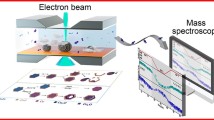Abstract
Solid phase transformation and metal solubility were monitored after coprecipitation of Cd2+, Cu2+, Pb2+ and Zn2+ with Fe3+ to form ferrihydrite by titration to pH 6. The (co)precipitates were aged at room temperature for up to 200 d and subsequently heated for 60 d at 70 °C. The mode of (co)precipitate formation, rapid and slow titration, was also investigated. Metal solubility was measured by anodic stripping voltammetry. Surface area, Fourier transform infrared (FTIR) and X-ray diffraction (XRD) analysis were used to follow the transformation of ferrihydrite after initial (co)precipitation. Electron microprobe analysis (EMPA) was used to show the distribution of metals within ferrihydrite aggregates. Thermal treatment produced a reduction in soluble Cd2+ and Zn2+, whereas Pb2+ appeared to be expelled from the solid phase. The more stable coprecipitate (formed by slow titration) maintained a constant Cu2+ solubility after thermal treatment. Characterization of the solid phase by XRD indicated that the presence of low levels of metals did not affect the initial or final transformation products, although metals present during the slow titration seemed to stabilize a higher surface area material. The rapid titration resulted in a less ordered (1-line) ferrihydrite than the slow titration (9-line). Furthermore, FTIR analysis indicated that the presence of metals promoted the formation of mixed (microcrystalline) end-products. The initial coprecipitation products seem to determine the final thermal transformation products. These transformation products include ferrihydrite, hematite (Hm), and goethite (Gt)- and lepidocrocite-like microcrystalline structures. Although experimental conditions were favorable for the homogeneous distribution of metals throughout the coprecipitate, EMPA suggests that Cu and Zn segregation within aggregates of Fe oxides occurs.
Similar content being viewed by others
References
Ainsworth CC, Pilon JL, Gassman PL, Van Der Sluys WG. 1994. Cobalt, cadmium, and lead sorption to hydrous iron oxide: Residence time effects. Soil Sci Soc Am J 58:1615–1623.
Anderson PR, Benjamin MM. 1985. Effects of silicon on the crystallization and adsorption properties of ferric oxides. Environ Sci Technol 19:1048–1053.
Cornell RM. 1988. The influence of some divalent cations on the transformation of ferrihydrite to more crystalline products. Clay Miner 23:329–332.
Cornell RM, Giovanoli R. 1987. Effect of manganese on the transformation of ferrihydrite into goethite and jacobsite in alkaline media. Clays Clay Miner 35:11–20.
Cornell RM, Giovanoli R. 1988. The influence of copper on the transformation of ferrihydrite (5Fe2O3-9H2O) into crystalline products in alkaline media. Polyhedron 7:385–391.
Cornell RM, Giovanoli R. 1989. Effect of cobalt on the formation of crystalline iron oxides from ferrihydrite in alkaline media. Clays Clay Miner 37:65–70.
Cornell RM, Schneider W, Giovanoli R. 1989. The transformation of ferrihydrite into lepidocrocite. Clay Miner 24:549–553.
Crawford RJ, Harding IH, Mainwaring DE. 1993. Adsorption and coprecipitation of single heavy metal ions onto the hydrated oxides of iron and chromium. Langmuir 9:3050–3056.
Ford RG, Bertsch PM, Farley KJ. 1997. Changes in transition and heavy metal partitioning during hydrous iron oxide aging. Environ Sci Technol 31:2028–2033.
Kinniburgh DG, Jackson ML, Syers JK. 1976. Adsorption of alkaline earth, transition, and heavy metal cations by hydrous oxide gels of iron and aluminum. Soil Sci Soc Am J 40:796–799.
Kolthoff IM, Moskovitz B. 1937. Studies on coprecipitation and aging. XI. Adsorption of ammonio copper ion on and coprecipitation with hydrous ferric oxides. Aging of the precipitate. J Phys Chem 41:629–644.
Manceau A, Charlet L, Boisset MC, Didier B, Spadini L. 1993. Sorption and spéciation of heavy metals on hydrous Fe and Mn oxides: From microscopic to macroscopic. Appl Clay Sci 7:201–223.
Martínez CE, McBride MB. 1998. Solubility of Cd2+, Cu2+, Pb2+, and Zn2+ in aged coprecipitates with amorphous iron hydroxides. Environ Sci Technol 32:743–748.
McBride MB. 1978. Retention of Cu2+, Ca2+, Mg2+, and Mn2+ by amorphous alumina. Soil Sci Soc Am J 42:27–31.
Nalovic LJ, Pedro G, Janot C. 1975. Demonstration by Mössbauer spectroscopy of the role played by transitional trace elements in the crystallogenesis of iron hydroxides (III). In: Bailey SW, editor. Proc Int Clay Conf. Wilmette, IL: Applied Publishing, p 601–610.
Sauve S, McBride MB, Hendershot WH. 1995. Ion-selective electrode measurements of copper (II) activity in contaminated soils. Arch Environ Contam Toxicol 29:373–379.
Schwertmann U, Murad E. 1983. Effect of pH on the formation of goethite and hematite from ferrihydrite. Clays Clay Miner 31:277–284.
Schwertmann U, Taylor RM. 1989. Iron oxides. In: Dixon JB, Weed SB, editors. Minerals in soil environments. Madison, WI: Soil Sci Soc Am. p 379–438.
Spadini L, Manceau A, Schindler PW, Charlet L. 1994. Structure and stability of Cd2+ surface complexes on ferric oxides 1. Results from EXAFS spectroscopy. J Colloid Interface Sci 168:73–86.
Willett IR, Chartres CJ, Nguyen TT. 1988. Migration of phosphate into aggregated particles of ferrihydrite. J Soil Sci 39:275–282.
Author information
Authors and Affiliations
Rights and permissions
About this article
Cite this article
Martínez, C.E., McBride, M.B. Coprecipitates of Cd, Cu, Pb and Zn in Iron Oxides: Solid Phase Transformation and Metal Solubility after Aging and Thermal Treatment. Clays Clay Miner. 46, 537–545 (1998). https://doi.org/10.1346/CCMN.1998.0460507
Received:
Accepted:
Published:
Issue Date:
DOI: https://doi.org/10.1346/CCMN.1998.0460507




